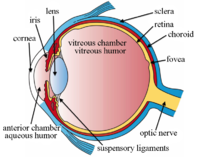
Photo from wikipedia
Intravitreal injections (IVTs) are common ophthalmic interventions and core competency for ophthalmologists. Although simple and relatively safe, complications do occur, including cataract and retinal detachment. It is common to encounter… Click to show full abstract
Intravitreal injections (IVTs) are common ophthalmic interventions and core competency for ophthalmologists. Although simple and relatively safe, complications do occur, including cataract and retinal detachment. It is common to encounter subjects who squeeze their eyes excessively during injections. Others move unexpectedly, particularly if pain is felt or if patients suffer dementia. Such situations add additional risk and may alarm the injector. Hard eye squeezing causes several problems. It narrows the palpebral aperture (PA), reducing the distance between injection site and eyelid margin, increasing risk of eyelash touch. Squeezing can elicit a Bell’s phenomenon, with upward gaze of the globe. If pain is felt, squeezing and movement can be marked and sudden, being particularly problematic with the needle in the eye. If movement is deemed too risky, injection treatment may be discontinued temporarily or permanently. No literature exists on optimal management of these situations. Often injectors do not adapt the IVT technique in these patients. We describe a simple and effective IVT technique which reduces severity and impact of these problems, and could be adopted as the default technique. It improves control of the injection process offering additional risk reduction in patients with the aforementioned difficulties. The technique has been adopted in real injection clinics. A series of photographs (Fig. 1a–f) were taken using a volunteer (Mary Awad) for demonstration of the technique without delivering an IVT, illustrating the advantages in a superotemporal IVT. The injector places a Barraquer speculum with solid flat blade (Fig. 1a). Figure 1a further shows inferonasal gaze without squeezing, demonstrating a large area of superotemporal sclera for injection. Figure 1b illustrates inferonasal gaze, with purposeful hard eye squeezing. The PA is significantly narrowed, limiting available injection sites. Figure 1c was taken after eliciting a sudden severe squeeze (with upward globe movement) secondary to unexpected instillation of G. Proxymetacaine onto the ocular surface and exposed eyelashes by the injector in an attempt to alleviate the problem. Figure 1d illustrates hand positioning for the modified IVT technique. The injector instructs the patient to look inferonasally, holding the syringe in their non-dominant hand between thumb and index finger. The point of injection is marked superotemporally with a calliper. The ring finger is placed on the upper solid part of the speculum and firm downward pressure applied, stabilising the globe in its downward gaze position, offering increased resistance to sudden ocular movements, securing the globe in a more stable position. The authors find it reduced narrowing of the PA during squeezing, maintaining a more constant distance between the upper speculum/eyelid margin and injection site. The dominant hand is free to inject the drug. This technique offers significant advantages over alternative methods of globe stabilisation, including utilisation of forceps, which results in a one-handed injection technique. A right-handed injector, if desired, can use this technique with their nondominant hand to stabilise the speculum either standing superiorly for left eyes or indeed standing on the right side of the patient for right eye injections, making the technique easy to learn and perform. * Winfried M Amoaku [email protected]